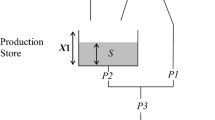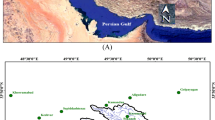Abstract
The purpose of this study is to investigate some of the factors controlling the rainfall-runoff relationship and, consequently, predicting flood events in a catchment. Primarily, the research is concerned with the study of rainfall and runoff with respect to various hydrometeorological and physical factors. An equation to predict the peak discharge is proposed. The prediction equation illustrates that the maximum peak discharge can be obtained as a function of rainfall intensity, rainfall duration, duration of rainfall up to time of concentration, and the previous discharge. Such analyses are considered vital as the basis for flood warning systems in the area under consideration.
Similar content being viewed by others
References
Beardmore, M., 1862, Manual of Hydrology, Waterlow, London.
Bransby-Williams, G., 1922. Flood discharge and the dimension of spillways in India, Engineering 134, 321–322.
Burnash, R. J. C. and Ferall, R. L., 1982, A system approach to real-time runoff analysis with a deterministic rainfall-runoff model, in V. P. Singh (ed.), Applied Modeling in Catchment Hydrology, Proc. of Intl. Symp. on Rainfall-Runoff Modelling, Mississippi State, Miss., 18–21 May 1981, W. R. P. Littleton, Colo., pp. 107–120.
Chorley, R. J. and Kennedy, B. A., 1971, Physical Geography, Prentice-Hall, London.
Chow, V. T., 1957, Report of the Committee on Runoff 1955–1956, Amer. Geophys. Union 38 (June 1957).
Chow, V. T., 1964, Handbook of Applied Hydrology, McGraw-Hill, New York.
Frind, E. O., 1969, Rainfall-runoff relationships expressed by distribution parameters, J. Hydrol. 9, 405–426.
Ghayoor, H. A., 1976, Rainfall-runoff relationship, D Phil thesis, University of Sussex, Brighton, England.
Goodhew, R. C., 1970, Weather is my business, Weather 25, 33–39.
Gregory, K. J., 1974, Streamflow and building activity, Inst. Br. Geogr. Soc. Special Publ. No. 6, pp. 7–22.
Hewlett, J. D. and Hibbert, A. R., 1967, Factors affecting the response of small watersheds to precipitation in humid areas, in W. E. Sopper and H. W. Lull (eds.), pp. 275–290.
Hickok, R. B., Keppel, R. V., and Rafferty, B. R., 1959, Hydrograph synthesis, Agric. Eng.
Hollis, G. E., 1974, The effect of urbanization of floods in the Canon's Brook, Harlow, Essex in fluvial processes in instrumented watersheds, Inst. Br. Geogr. Soc. Special Publ. No. 6, pp. 123–139.
Horton, R. C., 1954, Erosional development of streams and their drainage basins, hydrophysical approach to quantitative morphology, Bull. Geol. Soc. Amer. 56, 275–370.
Jamieson, D. G. and Amerman, C. R. 1969, Quick-return subsurface flow, J. Hydrol. 8, 122–136.
Kirpich, Z. P., 1940, Time of concentration of small agricultural watersheds, Civil Engrs. 10 (6), 362.
Lee, J. and Bray, D. I., 1969, The estimation of runoff from rainfall for New Brunswick watersheds, J. Hydrol. 9, 427–437.
Linsley, R. K., 1967, The relation between rainfall and runoff, J. Hydrol. 5, 297–311.
Linsley, R. K., Kohler, M. A., and Paulhus, J. L. H., 1949. Applied Hydrology, McGraw-Hill, New York.
Linssley, R. K. and Ackermann, W. C., 1942, Method of predicting the runoff from rainfall, Trans. Amer. Soc. Civ. Engrs. 10, Paper No. 2147, 825–846.
Philip, J. R., 1958, The theory of infiltration. The infiltration equation and its solution, Soil Sci. 83, 345–357, 435–448; 84, 163–177, 257–264, 329–339; 85, 278–286, 333–337.
Rossmiller, R. L., 1980, The ratinal formula revised, Proc. of Inter. Symp. on Urban Storm Runoff, July 28–31 1980, University of Kentucky, Lexington.
Singh, V. P., 1988, Hydrologic Systems Vol. 1, Rainfall-Runoff Modeling, Prentice Hall, New Jersey.
Sorooshian, S., 1983, Surface water hydrology: On line estimation, Rev. Geophys. Space Phys. 21, (3), 706–721.
Weyman, D. R., 1975, Runoff Processes and Streamflow Modelling, Oxford University Press.
Wolf, P. O., 1966, Comparison of methods of flood estimation, River Flood Hydrology, Symposium of 18 March 1965, ICE, London.
Author information
Authors and Affiliations
Rights and permissions
About this article
Cite this article
Ghayoor, H.A. Prediction of peak runoff from rainfall in a temperate area. Water Resour Manage 5, 63–84 (1991). https://doi.org/10.1007/BF00422039
Received:
Accepted:
Issue Date:
DOI: https://doi.org/10.1007/BF00422039




